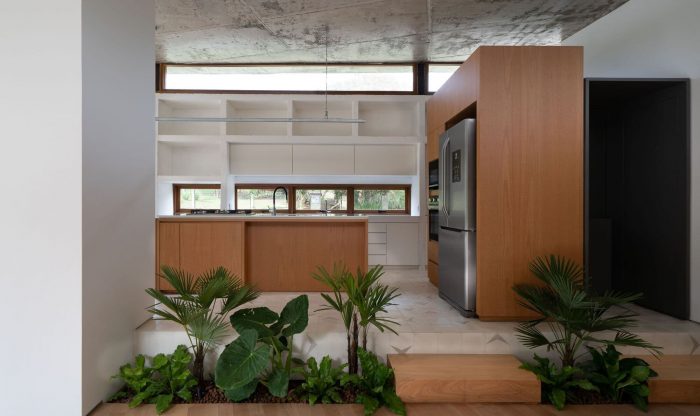背景和建议。客户的委托是一个单层的家庭住宅,按照常规的计划组织,包含三个套房,一个书房/图书馆区,以及一个开放式厨房。
Context and Proposals. The client’s commission was a one-story family house, organized on a regular plan containing three suites, a study/library area, and an open kitchen.
该地块位于一个环境保护区,因此地块非常宽阔,其地形形成了一个从街道到受保护的树林的缓坡。可建区域的几何形状–尊重路线和后退–形成一个朝北的梯形开口,这是一个非常有利的阳光条件。
The site is located along an environment-protected area – resulting in a very wide plot – and its topography forms a gentle slope from the street down towards the protected woods. The geometry of the buildable area – respecting alignments and setbacks – forms a trapezoid opening towards the north, a very favorable condition for sunlight.
策略。该项目通过定位两个体量来安排。其中一个,平行于受保护的树林的排列,包含了房子的私密区域。另一个是厨房,与地块的正面平行。在它们之间创造了一个空隙,它的顶部是一个屋顶计划,容纳了社会区域。这些决定的目的是组织一个线性计划,将卧室转向树林;利用太阳方向和地块的几何关系,使社交区尽可能透明;并与厨房的体积一起定义一个正面–更封闭和私人。房屋的私密和社交区域被放置在地块的下部,这为这些区域提供了进一步的私密性。不同的楼层以一个内部花园为标志,增加了房屋与场地自然环境的渗透性,也作为一条槽线,加强了项目的构成姿态。
Strategy. The project is arranged by positioning two volumes. One of them, parallel to the alignment of the protected woods, contains the intimate areas of the house. The other houses the kitchen and is located parallel to the front alignment of the plot. A void is created between them which, topped by a roof plan, accommodates the social area. These decisions aim to organize a linear plan, turning the bedrooms towards the woods; to take advantage of the relationship between the solar orientation and the geometry of the plot, allowing the social areas to be as transparent as possible; and to define a front facade with the volume of the kitchen – more closed and private. The intimate and social areas of the house are placed on the lower portion of the plot, which provides further intimacy to these areas. The different levels are marked by an internal garden that increases the permeability of the house to the natural environment of the site, also working as a groove line that reinforces the compositional gesture of the project.
形式和构成。容纳房屋私密区域的体量是实心的,几乎完全不透明,只向森林和天花板开放,它由暴露的陶瓷砖制成,并被挤压以容纳蓄水池和洗衣房。厨房体量被分解成三个体量:一个是衔接入口前庭和盥洗室的体量,另一个是建筑的外墙,组织了厨房的所有功能;第三个–包含壁炉和烧烤架–定义了厨房和生活之间的空间界限。
Form and Composition. The volume that houses the intimate areas of the house is solid, almost completely opaque, opening only to the forest and ceiling, it is made of exposed ceramic bricks and is extruded to accommodate a water reservoir and laundry. The kitchen volume is decomposed into three volumes: one that articulates the access vestibule and the lavatory, another that is the facade of the building and organizes all the functions of the kitchen; and a third – containing the fireplace and barbecue – defines the spatial boundary between kitchen and living.
在起居室和厨房的体量上,屋顶是一块梯形的裸露混凝土平板。对角线的褶皱增强了结构的刚性,并允许雨水的排放;梯形的四角被提升到不同的水平,提高了社交区的天花板高度,以增加光线的入射,并降低了厨房的高度,以提供舒适感。
Over the living and kitchen volumes, the roof is a flat slab of exposed concrete in a trapezoidal shape. A diagonal fold enhances structural rigidity and allows rainwater drainage; the corners of the trapezoid are lifted to different levels, raising the ceiling height of the social area for a greater incidence of light, and lowering it in the kitchen to provide coziness.
其结果是一个强烈的建筑对象,其水平性推动了构图的决定。这些元素被插入和调整,以解决形式的线性和水平方面的问题:有时减弱,有时反对,有时加强。这种游戏的结果是,空间的光线和视觉效果丰富,场地获得更大的使用和沉思潜力。规划的规则性和亲密区域的体积导致了更多的中性空间。空间在这里不是主角,它欢迎。在社交区,空间的几何形状定义了视角,扩展了感知,并暗示了特殊性。它激起了人们的兴趣。材料的表面状态(陶瓷砖、混凝土、木材和玻璃)似乎以一种触觉和舒适的方式与周围环境的色调和纹理相结合。空间物质化,仿佛由环绕它们的相同物质构成。
The result is an intense architectural object, whose horizontality drives the composition decisions. The elements are inserted and adjusted to address the linear and horizontal aspects of the form: sometimes attenuating, sometimes opposing, and sometimes reinforcing. This game results in spaces rich in light and visuals and the site gain greater potential for use and contemplation. The regularity of the plan and the volume of the intimate areas result in more neutral spaces. Space here is not the protagonist, it welcomes. In the social areas, the geometry of the spaces defines perspectives, expands perceptions, and suggests exceptionalities. It provokes. The materials in their apparent state (ceramic bricks, concrete, wood, and glass) seem to combine – in a tactile and comfortable way – with the shades and textures of the surroundings. Spaces materialize as if made of the same substance that surrounds them.
Architects: Trika Arquitetura
Area : 2906 ft²
Year : 2022
Photographs :Roberta Gewehr
Manufacturers : Elevato, Estudio Luiza Pilau, Geomatec, Laboratório da Luz, Lucente, Marmoraria Capelari e Radin, Marmoraria Faccio, Moutinho Madeiras, Móveis Reche, Turen Portas Internas
Autores : Arq. Helena Karpouzas, Arq. Luciano de Topin Ribeiro
Structural Design : Pasquali e Associados Engenharia de Estruturas
Electrical And Hydraulic Installation Projects : Arq Ricardo Sassen Paz
Air Conditioning Project : Eng. Felipe Karpouzas
City : Gravataí district
Country : Brazil







































